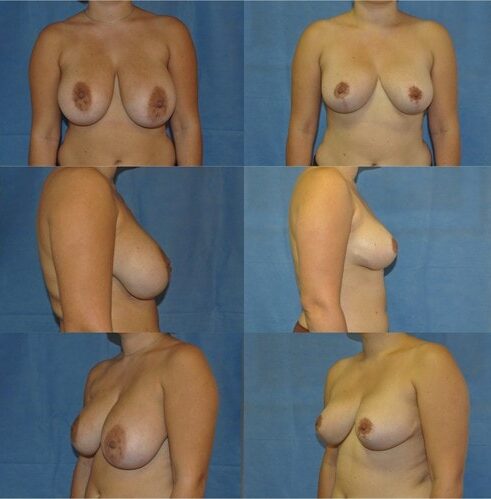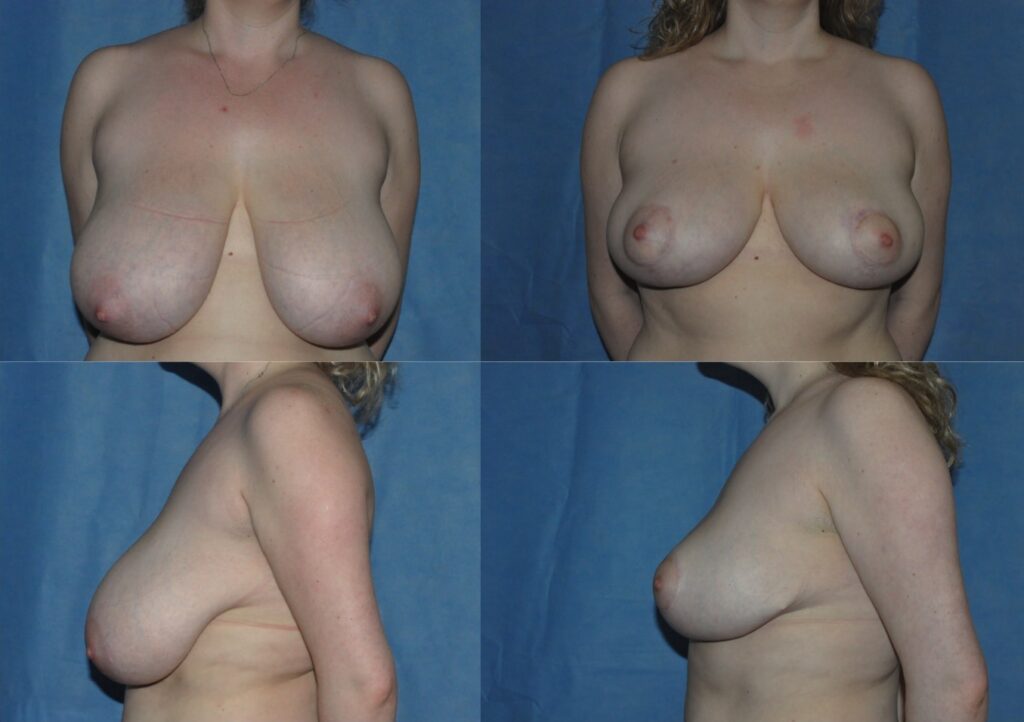Breast Reduction Surgery
Tunbridge Wells, Kent, London
As celebrated as the female figure is today, oversized breasts are often considered a burden by those who bear them. Large breasts can cause physical discomfort, psychological distress, limitations with clothing and exercise, and more. Breast reduction surgery is a solution for many women that offers relief, comfort, and an enhanced quality of life overall.
Renowned for his expertise in corrective surgeries and specialised breast plastic surgery techniques, Marc Pacifico offers a safe, positive surgical experience and outstanding results.
What Is Breast Reduction Surgery?
Breast reduction surgery, or reduction mammaplasty, is a plastic surgery procedure designed to reduce the size of the breasts by removing excess breast tissue. Breast reduction surgery also involves reshaping and elevating the breasts, resulting in a smaller and more proportionate bustline.
While pursuing any plastic surgery procedure is a significant and deeply personal choice, many women report having a breast reduction as one of the best decisions they have ever made for themselves. Breast reduction surgery has some of the highest satisfaction rates due to its ability to powerfully improve the quality of life for many patients.
I Finally Love My Body
“As a young woman with a smaller frame having large breasts was very hard on my body image. I felt safe and respected whilst going through all the procedures and I thank Dr Pacifico for so much! Happy!”
–
RealSelf Patient Review
Am I a Candidate for Breast Reduction Surgery?
If you are dissatisfied with the size of your breasts, you may be a candidate for breast reduction surgery.
Medical reasons for breast reduction include:
- Chronic back pain, neck pain, or shoulder pain that is resistant to medication
- Skin irritation or infections underneath the breasts
- Poor posture or musculoskeletal complaints due to the weight of the breasts
- Poor self-image or psychological distress due to large breasts
Good candidates are non-smokers who are in good health, ideally with a body mass index of below 30, and have realistic expectations about their results.
To learn if you are a candidate for breast reduction, schedule a consultation with Mr Pacifico today by calling 44 (0) 1892 536960.
What are the Benefits of Breast Reduction Surgery?
Breast reduction surgery offers patients both aesthetic and functional benefits. Breast reduction techniques can:
- Reduce the volume, size, and weight of breasts
- Provide a breast lift
- Relieve pain in the back, neck, and shoulders
- Improve the posture
- Reduce skin irritation
- Improve the comfort and quality of your sleep
- Create more balanced proportions
- Improve the way clothing fits
- Enhance your confidence and body image
No more bra straps digging into your shoulders. No more avoiding exercise. No more unwanted attention. After breast reduction surgery, many women not only feel more comfortable in their own bodies but feel they can move through life with confidence. Breast reduction is a truly transformative and liberating procedure that enables patients to embrace their lives fully, finally.
How Is Breast Reduction Surgery Performed?
Your breasts are reduced by removing breast tissue from below and around your nipple, and the nipple is raised to a higher position. The breast skin is then stitched, leaving you with a scar around the areola (the coloured skin surrounding the nipple), vertically down from the areola to the crease under the breast, and then horizontally along the breast crease (i.e., the scar is shaped like an inverted letter “T” or an anchor).
A breast reduction is performed under general anaesthesia (with you asleep). You will wake up with surgical tape along the wounds and a surgical drain (tube) coming out of each breast. You will need to go into a supportive post-surgical or sports bra following surgery.
What is the Recovery Period for Breast Reduction Surgery?
Breast reduction surgery takes place as a day case procedure, with no need for surgical drainage tubes. You should wear a supportive post-surgical bra (that we will supply) day and night for at least six weeks after surgery and sometimes for three months.
How long before daily activities may be resumed?
Strenuous activity should be avoided for at least two weeks. You may be able to drive after this period, but remember that you need to be comfortable in performing an emergency stop or similar manoeuvres. If you drive too early and you need to make an emergency stop, the wounds may come apart from the pressure of the seatbelt.
How Much Does Breast Reduction Surgery Cost?
The cost of your breast reduction procedure will vary depending on a variety of factors, including anaesthesia fees, facility fees, the extent of the surgery, and more.
For a personalised quote and to ask questions pertaining to the financial details of your procedure, it’s best to schedule a consultation with Mr Pacifico.
Breast Reduction FAQ
Does UK health insurance cover breast reduction surgery?
Whilst private medical insurance will occasionally cover breast reduction surgery, Mr Pacifico does not perform breast reduction procedures as insured cases.
How long does breast reduction surgery take?
The surgery takes about 2–3 hours, depending on the extent of reduction and other individual factors.
What are the success rates?
Of all the plastic surgery procedures we perform, breast reduction is consistently shown to have the highest patient satisfaction rate.

Are there any risks with breast reduction surgery?
As for any plastic surgery procedure, there is a risk for complications to occur in breast reduction surgery. These include surgical wound infection and wound healing issues (most common at the T junction where the scars meet), as well as bleeding after surgery requiring going back to the operating theatre.
Whilst most scars settle down well, some people form lumpy scarring that may need further treatment. There can be issues with the nipple, such as a change (or loss) in sensation, and very rarely, death of the nipple due to damaged blood supply. Fat necrosis describes the breakdown and death of fat within the breast due to poor blood supply, and “bottoming out” describes the breast, over time, descending below the level of the nipples.
Some degree of breast asymmetry is normal, but significant asymmetry may need to be addressed with further surgery. Overall, revision surgery (for any reason) may be indicated in up to 10% of patients. Finally, blood clots such as deep vein thrombosis (DVT) or pulmonary embolism ( PE) are a risk with any surgery but are fortunately rare in breast reduction.
Videos
Types Of Breast Reduction
Marc Pacifico Breast Reduction FAQs
Expectations in Plastic Surgery
Watch More Videos on YouTube:
Before and After Photos

Want to Learn More about Breast Reduction in Tunbridge Wells?
If you are considering breast reduction surgery, it’s essential to seek out the expertise of a highly experienced surgeon. Mr Pacifico is a consultant plastic surgeon with years of experience in specialised breast enhancement procedures. He and his team are here to ensure you have a safe, positive experience and walk away with beautiful results.
To schedule a consultation, fill out our online contact form or give us a call at 44 (0) 1892 536960. We look forward to aiding you on your journey to comfort and confidence.
Make an Enquiry
